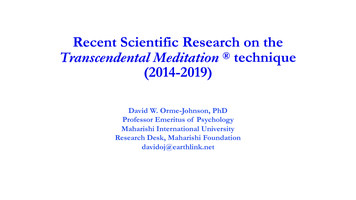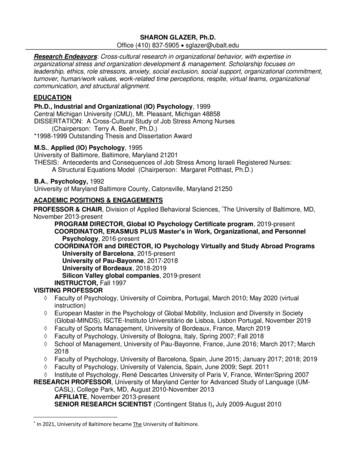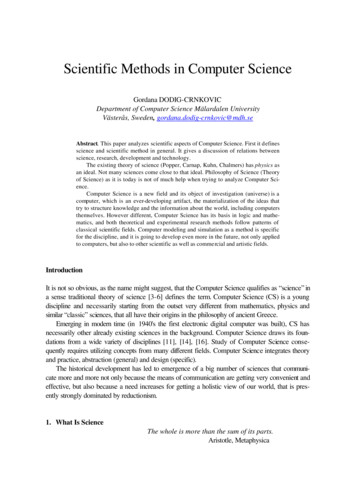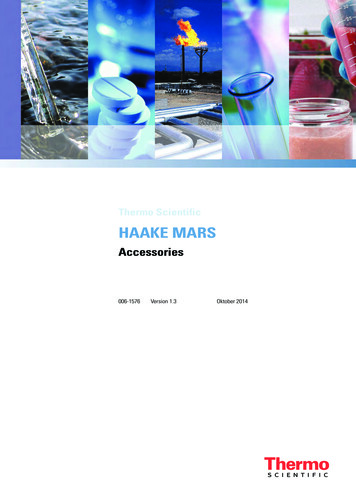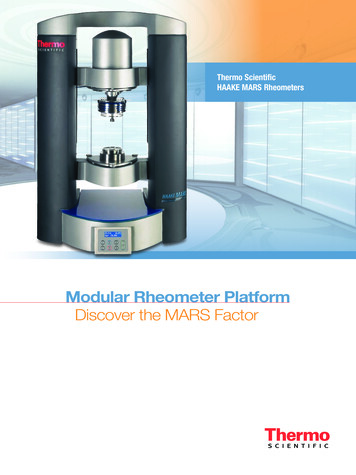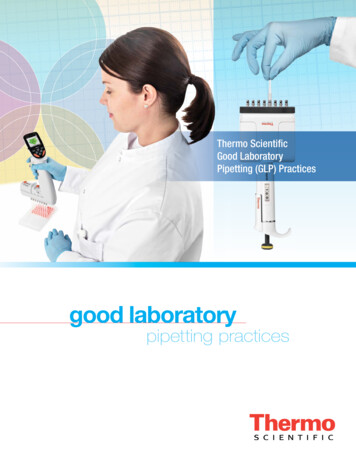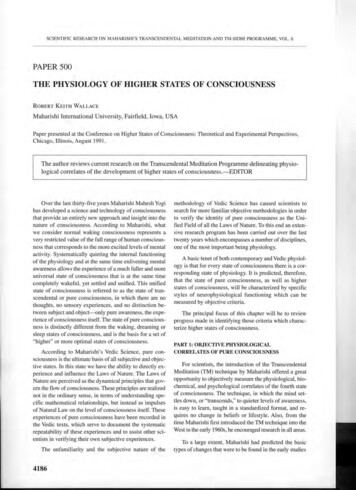
Transcription
SCIENTIFIC RESEARCH ON MAHARISHI'S TRANSCENDENTAL MEDITATION AND TM-SIDHI PROGRAMME, VOL. 6PAPER500\THE PHYSIOLOGY OF HIGHER STATES OF CONSCIOUSNESSROBERT KEITH WALLACEMaharishi International University, Fairfield, Iowa, USAPaper presented at the Conference on Higher States of Consciousness: Theoretical and Experimental Perspectives,Chicago, Illinois, August 1991.The author reviews current research on the Transcendental Meditation Programme delineating physiological correlates of the development of higher states of consciousness.- EDITOROver the last thirty-five years Maharishi Mahesh Yogihas developed a science and technology of consciousnessthat provide an entirely new approach and insight into thenature of consciousness. According to Maharishi, whatwe consider normal waking consciousness represents avery restricted value of the full range of human consciousness that corresponds to the more excited levels of mentalactivity. Systematically quieting the internal functioningof the physiology and at the same time enlivening mentalawareness allows the experience of a much fuller and moreuniversal state of consciousness that is at the same timecompletely wakeful, yet settled and unified . This unifiedstate of consciousness is referred to as the state of transcendental or pure consciousness, in which there are nothoughts, no sensory experiences, and no distinction between subject and object-only pure awareness, the experience of consciousness itself. The state of pure consciousness is distinctly different from the waking, dreaming orsleep states of consciousness, and is the basis for a set of"higher" or more optimal states of consciousness.According to Maharishi 's Vedic Science, pure consciousness is the ultimate basis of all subjective and objective states. In this state we have the ability to directly experience and influence the Laws of Nature. The Laws ofNature are perceived as the dynamical principles that govern the flow of consciousness. These principles are realizednot in the ordinary sense, in terms of understanding specific mathematical relationships, but instead as impulsesof Natural Law on the level of consciousness itself. Theseexperiences of pure consciousness have been recorded inthe Vedic texts, which serve to document the systematicrepeatability of these experiences and to assist other scientists in verifying their own subjective experiences.The unfamiliarity and the subjective nature of the4186methodology of Vedic Science has caused scientists tosearch for more familiar objective methodologies in orderto verify the identity of pure consciousness as the Unified Field of all the Laws of Nature. To this end an extensive research program has been carried out over the lasttwenty years which encompasses a number of disciplines,one of the most important being physiology.A basic tenet of both contemporary and Vedic physiology is that for every state of consciousness there is a corresponding state of physiology. It is predicted, therefore,that the state of pure consciousness, as well as higherstates of consciousness, will be characterized by specificstyles of neurophysiological functioning which can bemeasured by objective criteria.The principal focus of this chapter will be to reviewprogress made in identifying those criteria which characterize higher states of consciousness.PART 1: OBJECTIVE PHYSIOLOGICALCORRELATES OF PURE CONSCIOUSNESSFor scientists, the introduction of the TranscendentalMeditation (TM) technique by Maharishi offered a greatopportunity to objectively measure the physiological, biochemical, and psychological correlates of the fourth stateof consciousness. The technique, in which the mind settles down, or "transcends," to quieter levels of awareness,is easy to learn, taught in a standardized format, and requires no change in beliefs or lifestyle. Also, from thetime Maharishi first introduced the TM technique into theWest in the early 1960s, he encouraged research in all areas.To a large extent, Maharishi had predicted the basictypes of changes that were to be found in the early studies
WALLACETHEORETICAL PAPERS-PHYSIOLOGY AND HEALTH: HIGHER STATES OF CONSCIOUSNESS -PAPERand in more elaborate studies to follow. For example, in hisbook The Science of Being and Art of Living, publishedin 1963, he stated that when the mind transcends duringTranscendental Meditation, the metabolism reaches itslowest point; so does the process of breathing, and thenervous system gains a state of "restful alertness" which,on the physical level, corresponds to the state of "blissconsciousness," the transcendental field of existence (pp.192-198, 204).Maharishi describes this state of restful alertness as afourth major state of consciousness distinct from waking,dreaming, and sleeping. The first major publication ofevidence verifying Maharishi 's predictions was in 1970 inthe journal Science, in the article, "Physiological Effectsof the Transcendental Meditation Technique" (Wallace,1970b). The conclusion of this and other early studies wasthat Transcendental Meditation produces a state of restfulalertness, indicative of a fourth major state of consciousness that is physiologically and biochemically unique.The findings showed first that the body achieved a deepstate of rest and relaxation as indicated by such parameters as a decrease in respiration rate and oxygen consumption, a marked increase in skin resistance, and a decreasein arterial lactate and plasma cortisol levels; and secondthat the mind achieved a relaxed yet inwardly alert stateas indicated by an increase in alpha and theta wave activity in the frontal parts of the brain and an overall increasein EEG coherence (Wallace et al., 1971; Wallace et al.,1972; Orme-Johnson & Farrow, 1976). Since these initialfindings , many hundreds of studies have been completedin all fields which, when taken together, support and enrich the concept of a transcendental or fourth state of consciousness (Chalmers, Clements, Schenkluhn, & Weinless,in press).In this section we will briefly address certain methodological issues which have helped clarify the existenceof a fourth state of consciousness, and will then highlightrecent fmdings in several key areas: respiration, musclemetabolism, hormones and neurotransmitters, EEG coherence, and meta-analysis.Methodological IssuesPerhaps the most important methodological issue is toidentify the independent variable-the state of pure consciousness. How do we actually know that what we aremeasuring during TM is the state of pure consciousness?Most of the early studies took a very general approach andcompared the average magnitude of a particular variablesuch as respiration rate during different experimental andcontrol periods. The average value of respiration rate during the meditation period, for example, was compared tothe value either during an equivalent resting or relaxation500control period. Unfortunately, with this type of design itis impossible to characterize specific periods in which thesubject is experiencing pure consciousness. During thepractice of the TM technique there appears to be a mixture of states; the technique itself is a dynamic one havingboth an "inward phase" and an "outward phase."In the inward phase subjects report their mental activity settling down to quieter levels until they eventuallytranscend all mental activity and experience the state of pureconsciousness. In the outward phase they report emergingfrom the state of pure consciousness and the gradual reappearance of more excited states of mental activity, untilthey begin the inward phase once again. The degree ofclarity subjects report in the expetience of pure consciousness varies greatly, as does the frequency and duration ofeach of these inward and outward phases. Subjects whoare overly tired before practicing the TM technique reporthaving short periods of drowsiness or even sleep duringmeditation. Through the entire 20 or 30 minutes of theTM technique there is often a mixture of active wakingstate, drowsiness , sleep or relaxation , quiet waking state,and transcending to a state of pure consciousness.According to Maharishi, deep rest allows the systemto "normalize" itself-that is, to remove any functional orstructural abnormalities. When one rests during a cold orillness the body's internal system spontaneously attemptsto remove any foreign invaders and to heal itself. In asimilar manner, according to Maharishi, when the bodysettles down to a state of restful alertness and one experiences pure consciousness, the internal systems of the bodyautomatically begin to remove any deep-seated stresses orabnormalities (Maharishi Mahesh Yogi, 1972, lesson 13).One of the consequences of this normalization processduring TM is that the mind shifts out of pure consciousness and either becomes more active, returning to a moreexcited state, or less active to the point of drowsiness oreven sleep. The mixture of states that occurs during thepractice of the TM technique thus is a direct consequenceof the dynamics of the procedure and the initial conditionof the individual's nervous system.The earlier research, which we refer to as phase I studies, did not carefully discriminate between this mixture ofstates during meditation. This has led to some confusionover the difference between the physiological correlatesof pure consciousness and those of relaxation and drowsiness. Later studies, which we refer to as phase II studies,have used subjective reports coupled with certain objective critetia, such as periods of respiratory suspension, tohelp selectively study periods of pure consciousness. Aswe shall see, these more recent and better-designed studies have demonstrated more marked and unique physiological changes.4187
SCIENTIFIC RESEARCH ON MAHARISHI'S TRANSCENDENTAL MEDITATION AND TM-SIDHI PROGRAMME, VOL. 6Another methodological problem that the later research has helped clarify is the use of appropriate dependent variable -that is, objective criteria which candiscriminate between the state of pure consciousness andother states. Researchers have tended to use physiological parameters that are too few and too limited. A classicexample of the problem of using limited measurementscan be seen in the first attempts to distinguish betweendreaming and waking through the use of electroencephalogram (EEG) patterns. The EEG pattern during dreaminglooks extremely similar to that during waking, and yetbehaviorally the two states are entirely different. Basedon these EEG patterns dreaming was initially referredto as "paradoxical" sleep. It was not until the observation by Aserinsky and Kleitman (1965) of so-called rapideye movements (REM) and the subsequent recording ofelectrooculograms (EOG) and electromyograms (EMG)during dreaming that clearly defined criteria were established which enabled physiological discriminationbetween dreaming, sleep, and wakefulness. Researchershave further characterized dreaming by variations in otherphysiological parameters (Dement & Masserman, 1964;Jouvet, 1967; Oswald, 1962; Snyder, Hobson, Morrison,& Goldfrank, 1964).The same point applies to research on the TM program. If only one or a few parameters are used it may notbe possible to discriminate between two states, such asrelaxation or pure consciousness, that might occur alternately during the TM technique. As the followi ng sectionsshow, by using a multidisciplinary approach to the studyof consciousness, subsequent research has demonstratedthat there exist discriminating parameters which are ableto better characterize the state of pure consciousness. Unless these measures are utilized, the unique characteristicsof this state may remain obscured.RespirationThe results of studies on respiration suggest the importance of looking at continuous measurements so thatthe "deeper" periods of meditation can be identified; andfurther, the importance of studying more advanced subjects who report clear experiences of pure consciousness.To some extent, this was done in one of the first studieson the TM technique. Allison (1970), in a report on oneadvanced subject, found that respiration rate decreasedfrom 12 breaths/min before meditation, to 4 breaths/minduring, and again returned to 12 breaths/min after meditation, with no evidence of compensatory breathing.A more extensive study by Farrow and Hebert ( 1982)has helped clarify these previous results (see Figure 1).In four independent experiments Farrow and Hebert attempted to determine frequencies of breath suspensionepisodes during the TM technique and whether these episodes were correlated with the experience of pure consciousness.In the first experiment, 95 subjects who had been practicing the TM technique from one month to 13 years werestudied before, during, and after meditation. Eleven of thesubjects exhibited a total of 151 breath suspension episodes, almost all occurring during the TM technique. In thesecond and third experiments, more advanced TM subjects were studied as well as nonmeditating controls, andthe criteria were altered so that they accounted for individual variations in average respiration time. As a result,the frequency of breath suspension episodes was greater.For example, in the second experiment, 21 of the 28 TMsubjects exhibited a total of 116 episodes, while 9 of the23 controls exhibited only a total of 14 breath suspensions.The frequency of episodes and mean, maximum, and totalepisode lengths were all substantially greater in the TMgroup than in the control group.Spontaneous Reduction of Breath Flow During Experiences ofTranscendental ConsciousnessPrecontrol (eyes open)Button Signals -. fTranscendental Meditation Technique'' ' ' 'Breath Flow (ml/sec)200 01Time (min)200Exha lefInhaleFIG. 1. In four different experiments a number of subjects were tested for spontaneous suspensions of breath during the Transcendental Meditation technique. The TM practitioners exhibited significantly more suspensions than controls. Subjects practicing the TMtechnique pressed a button after each experience of Transcendental Consciousness-the subjective experience of an extremely settledand expanded state of awareness. Each button press closely corresponded to the end of a period of markedly reduced breath flow.4188
WALLACETHEORETICAL PAPERS-PHYSIOLOGY AND HEALTH: HIGHER STATES OF CONSCIOUSNESS -PAPERIn the third experiment there was an attempt to correlate the occurrence of breath suspensions with the subjective experience of phre consciousness. In this experimentall subjects had participated in advanced courses designedto deepen and extend the clarity of experience in meditation; all reported frequent and sustained experiences ofpure consciousness during meditation. Subjects were givenan event marker button and instructed to push the buttonafter each experience of pure consciousness. A large percentage of the button presses noting the experience of pureconsciousness occurred within 10 seconds of the offset ofone of the 57 breath suspensions. The temporal distribution of button presses was significantly related to the distribution of breath suspension episodes, indicating thatbreath suspension is a physiological correlate of some,but not all, episodes of pure consciousness.In the fourth experiment one very advanced TM meditator, who reported frequent clear experience of pureconsciousness, was studied over six sessions. Respirationrate, minute ventilation, oxygen consumption, basal andphasic skin resistance, heart rate, EOG, and EEG weremeasured. In three sessions the subject was given an eventmarker button to press after each experience of pure consciousness. In almost all cases the event marks occurredimmediately after a period during which breath flow decreased to nearly zero, indicating a clear and consistentcorrelation between periods of respiratory suspension andthe subjective experience of pure consciousness. Eventmarks and periods of breath suspension were not presentin the records during either the precontrol, eyes-open period or the postcontrol, eyes-closed, and eyes-open periods; however, some did occur near the end of the precontrol, eyes-closed period. As is the case with many subjects,there is often a spontaneous drifting into the practice of theTM technique during the precontrol eyes-closed period.Over five sessions, there were 191 breath suspensions,occurring at a mean rate of one every 52 sec. The meanperiod of breath suspension and experience of pure consciousness was about 18 sec, with the longest period about35 sec. A detailed analysis of the air flow during periodsof breath suspension showed that it did not entirely stopbut continued with high-frequency, low-amplitude fluctuations at about 2 Hz and 4.5 Hz.One key question asked by Farrow and Hebert in theseexperiments was whether or not the breath suspension periods were intentional. In all experiments subjects wereblind to the purpose of the experiment; several sessionsemployed further equipment and conditions which reducedor eliminated the subject's awareness that respiration wasbeing measured. In a number of the sessions, for example,multiple electrodes were attached for other measurements. To determine whether the breath suspensions were500intentional, the compensatory hyperventilation seen after intentional breath suspension periods was analyzedand compared to breathing activity following respiratorysuspensions during the TM technique. A subject askedto intentionally hold his breath for time periods similarto the TM respiratory suspensions showed a significantand marked increase in minute ventilation (2.71liters perminute), as compared to a nonsignificant increase (0.57liters per minute) after the periods of respiratory suspension during the TM technique.Another concern was to distinguish the periods of respiratory suspension seen during sleep apnea from thoseduring the TM technique. This was determined by the factthat EOG measurements during the TM technique did notshow the typical, slow-rolling eye movements precedingor associated with sleep apnea.Several other recent studies have extended Farrow andHebert's results and have more carefully analyzed the neurophysiological control of respiratory patterns during theTM technique. For example, Wolkove, Kreisman, Darragh, Cohen, and Frank (1984), comparing long-term TMsubjects with nonmeditating controls at rest, confirmedFarrow and Hebert's findings of both a significant declineof minute ventilation and the observation of periods ofrespiratory suspension in TM subjects. Also, several studies have found that when TM subjects were given increasing amounts of carbon dioxide in inspired air there was areduced respiratory response. This suggested a decreasedsensitivity to high carbon dioxide concentration and analteration in the neurophysiological mechanisms whichregulate breathing (Wolkove et al., 1984; Singh, 1984).The most extensive investigation in this area is that ofKesterson (1986). In this study a cross section of groupsofTM and TM-Sidhi participants were tested during theirgroup practice of the TM -Sidhi program. Three categoriesof subjects were identified according to their pattern ofbreathing while practicing the TM technique.The first group showed no changes in the frequency ofbreathing during meditation, the second a large decreasein the rate of breathing, and the third group prominent,frequent periods of respiratory suspension. The subjectsin the third group were studied extensively in order todetermine the underlying neurophysiological mechanisms producing the suspensions. Similar to the fmdingsofWolkove et al. (1984) and Singh (1984), these subjectsdemonstrated decreased sensitivity to high levels of carbon dioxide in ambient air during meditation. Further,they showed an increased sensitivity to low levels ofoxygen. It was also discovered that many of the subjectsdemonstrating spontaneous suspensions during meditation were, in fact, breathing apneustically-that is, the4189
SCIENTIFIC RESEARCH ON MAHARISHI'S TRANSCENDENTAL MEDITATION AND TM-SIDHI PROGRAMME, VOL. 6suspension began with a full inspiration and continuedwith a gradual inspiration during the suspension.\Furthermore, Kesterson discovered a drop in the respiratory quotient (RQ-the ratio of carbon dioxide produced/oxygen consumed) for almost all subjects in hisexperiment during the practice of TM. He hypothesizedthat this drop was a consequence of mild hypoventilation, which is known to decrease RQ. He demonstratedin a series of separate experiments that, in fact, alveolarventilation decreased significantly more than oxygen consumption for meditators during TM, but not for nonmeditating controls during relaxation-an argument in favor ofhypoventilation. He cites this change as further evidencefor brainstem inhibition of respiratory control during TM.Kesterson suggests his findings are contrary to previousmodels which hypothesized that the respiratory changesobserved during TM originate in decreased metabolicneeds. His findings indicate that they are a result of specificalterations in neurophysiological centers within the brain,more specifically those respiratory centers in the medullainvolved with the regulation of inspiration and expiration.Kesterson's research suggests that oxygen consumptionmay not be as good a discriminator of transcending asrespiratory patterns. Oxygen consumption is sensitive tobodily movements ; and any state of rest or relaxation willresult in a gradual decrease in metabolic rate. The specificpatterns of respiratory activity during the TM techniqueseem, according to Kesterson 's finding, to be better indicators of the subjective experience of transcending, especially when coupled with other physiological measurements such as EEG coherence.were also the most alert and reported the best experiences.Kesterson argues that the changes in breathing patternsignify a unique transitional state-the unified state ofpure consciousness-which underlies the three separatestates of consciousness, waking, dreaming, and sleeping.Muscle MetabolismOne of the first biochemical findings noted in subjects during the TM technique was a marked decrease inthe level of lactate in arterial blood and a continued lowlevel afterward (Wallace et al. , 1971 ). Lactate or lacticacid is the by-product of a less efficient type of metabolism known as anaerobic metabolism, which occurs whencells are not able to utilize oxygen. Even under normalconditions anaerobic metabolism exists and, as a result, acertain amount of lactate is constantly being produced byvarious cells in the body. Lactate production is dramatically increased in situations where the oxygen supply iseliminated or decreased in certain cells in the body. Forexample, in the skeletal muscle cells of a runner who issprinting the last hundred yards of a mile race, the cellsmust rely on anaerobic metabolism even though it is lessefficient. During these last hundred yards the runner isbuilding up what is known as an oxygen debt, which is indicated by the increased production of lactic acid or lactate.The most important conclusions drawn by Kesterson,however, are those concerning changes in states of consciousness. Sullivan (1980) has noted that respiratorypattern is a good discriminator between sleep, dreamingand wakefulness-that is, between states of consciousness. In fact, he suggests that if respiratory physiologistshad discovered REM sleep instead of EEG researchers , itwould have been called RERM, Rapid Erratic RespiratoryMovements. Deep sleep is characterized by slow, periodicmonotonous patterns, REM sleep by irregular variationsunrelated to carbon dioxide control, and wakefulness byregular patterns greatly modified during different activities. Brainstem inhibition of respiratory centers, a buildupof carbon dioxide, a drop in RQ and mild hypoventilationare all known to accompany the transition between thesestates of consciousness.At the University of California at Irvine, Jevning andWilson replicated and extended the early findings on decreased levels of arterial lactate during the TM techniquein a series of well-controlled experiments, comparing TMmeditators to nonmeditating controls (Jevning, Wilson,Smith, & Morton, 1978; Jevning, Wilson, Pirkle, O'Halloran, & Walsh, 1983). Jevning and Wilson also studiedforearm muscle blood flow (Jevning, Wilson, O' Halloran,& Walsh, 1983), revealing another intriguing and unexpected finding. In addition to measuring blood flow theymeasured the partial pressure and absolute levels of oxygen and carbon dioxide of the arterial and venous blood inthe forearm ofTM subjects during meditation and in nonmeditating controls during rest. From these measurementsthey were able to calculate the metabolic activity of theforearm muscles. They found the normal difference inoxygen content of the arterial and venous blood was significantly reduced in TM meditators during meditation, ascompared to controls during rest. This suggests that lessoxygen was being used by the cells, indicating a state oflower metabolism and deeper rest in the muscles of theTM subjects.The respiratory patterns demonstrated by advancedTM meditators and investigated by Kesterson are indicative of a transition from normal waking consciousness toa state of restful alertness. The subjects who showed thegreatest changes in breathing pattern while meditatingMore interestingly, they found that the normal difference in carbon dioxide content of arterial and venousblood was markedly reduced in TM subjects during meditation, with a less marked reduction in the controls during rest. These findings indicated a decrease or complete4190
WALLACETHEORETICAL PAPERS- PHYSIOLOGY AND HEALTH: HIGHER STATES OF CONSCIOUSNESS -PAPERcessation of carbon dioxide production by the forearmmuscles after 20-3Q minutes of TM. Calculations of therespiratory quotient during meditation showed a value ofalmost zero, as compared to the normal value of about .60.Thus, a dramatic alteration in local metabolism occurs asa result of the TM technique. This change is particularlyinteresting in the light of the earlier research, whichshowed no changes in the systemic levels of oxygen andcarbon dioxide as reflected by the partial pressure of arterial oxygen and carbon dioxide levels (Wallace et al., 1971 ).Wilson, Jevning, and Guich (1987) speculate that thechanges may be due to an alteration in fat metabolism. Toaccount for the fact that carbon dioxide is not produced, itis necessary to postulate that the two- or three-carbon fragments produced do not enter the tricarboxylic acid cycle.Two metabolic pathways which may not involve carbondioxide production are beta-oxidation of fatty acids, andglycolysis. Wilson et al. suggest that fatty acid oxidationis the more likely of these pathways for a number of reasons: one is that the previously observed decrease in bloodlactate during the TM technique suggests that the endproducts of glycolysis are not being formed .In order to account for the low arterial-venous carbondioxide content it is also necessary to explain why theproducts of fatty acid metabolism do not enter the tticarboxylic acid cycle. Wilson et al. speculate that under theresting conditions of the experiment the energy production may exceed utilization, producing conditions whichinhibit the further normal metabolism of these products.These unmetabolized products must undergo further oxi-500dation at some other site or organ in the body. The reported marked increase in brain blood flow suggests thatperhaps oxidation of these products is occurring there.Further research is being conducted in this area in orderto reveal the mechanics and significance of these findings .Hormones and NeurotransmittersSeveral different research groups have investigatedhormonal and neurotransmitter changes during the TMtechnique. Findings have been reported during the TMtechnique such as a decrease in plasma cortisol (Jevning,Wilson, & Davidson, 1978-see Figure 2), and an increase in phenylalanine (Jevning, Pirkle, & Wilson, 1977)in TM meditators as compared to resting controls. Researchers have found changes in meditators after periodsof practicing TM such as: an increase in plasma prolactin(Jevning, Wilson, & Vanderlaan, 1978), an increase in urinary 5-hydroxyindole-3-acetic acid (Bujatti & Riederer,1976) and a decrease in urinary free cortisol and serumthyroxine levels (Bevan, Young, Wellby, Nenadovic, &Dickins, 1976; Bevan, 1980).One of the most interesting hormonal studies is a longitudinal study on plasma hormone levels by Werner et al.(1986) in TM-Sidhi participants. Blood samples were takenin subjects practicing the TM technique just prior to theirstarting the more advanced TM-Sidhi program, and thenduring sessions at intervals of 5, 49, 115, and 167 weeksafter starting. During each session samples were takenover five consecutive days. The results showed significantlongitudinal decreases in some hormone levels, particularlyReduced Cortisol-6.0u5.505.032OlE.RelaxationTM(f)t04.5 4.0()E(f) a.3.53.0Before DuringAfterBefore During AfterFIG. 2. Cortisol is a hormone in the bloodstream which is found in large concentrations during stress, fasting, or dehydration. Thisstudy found that people who had been practicing the Transcendental Meditation program for three to five years had significantlylower cortisol levels during the TM technique compared to just before beginning the technique (p .01), and significantly lowerlevels during TM compared to controls who were resting with eyes closed (p .03).4191
SCIENTIFIC RESEARCH ON MAHARISHI 'S TRANSCENDENTAL MEDITATION AND TM-SIDHI PROGRAMME, VOL. 6in the pituitary hormones-thyroid stimulating hormone(TSH), growth hormone, and prolactin-with no marked1change in cortisol or the thyroid hormones T3 and T4.Werner et al. speculate that the relatively unchangedlevels of the thyroid hormones (despite continually decreasing TSH levels) imply either a marked increase inthe sensitivity of the regulation of the thy
SCIENTIFIC RESEARCH ON MAHARISHI'S TRANSCENDENTAL MEDITATION AND TM-SIDHI PROGRAMME, VOL. 6 Another methodological problem that the later re search has helped clarify is the use of appropriate de pendent variable -that is, objective criteria which can discriminate

